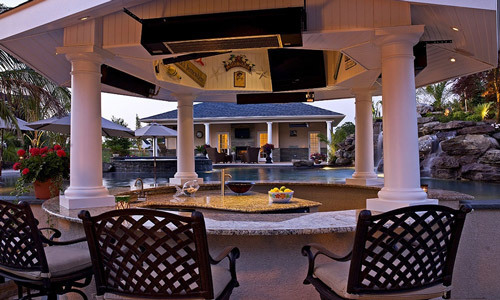3 of the Most Common Outdoor Heating Options to Keep Your Outdoor Living Space Warm
5 minute read | Heaters

Creating a comfortable outdoor living space is a dream for many. Whether it’s for hosting friends, enjoying a quiet evening, or simply relaxing in the fresh air, having a warm and inviting patio can make all the difference. To truly enjoy your outdoor area, especially during cooler months, investing in an outdoor heater is a smart choice. These heaters can extend the usability of your space well into the fall and even early winter, making it more enjoyable year-round.
When choosing an outdoor heater, you’ll find several options available, each with its own advantages. The three most popular types are liquid propane heaters, natural gas heaters, and electric heaters. Each offers unique benefits depending on your needs, budget, and how you plan to use your outdoor space.
Liquid Propane Heaters
Liquid propane (LP) heaters are among the most widely used heating solutions for patios and outdoor areas. They resemble a tall mushroom shape and are often placed overhead to provide direct heat to those sitting below. One of the main perks of LP heaters is their portability. Since they run on propane tanks, they’re easy to move around, making them ideal for spaces that need flexible heating setups.
These heaters are lightweight and often come with wheels, allowing you to easily reposition them as needed. Many cafes, restaurants, and event spaces rely on them due to their mobility and ease of use. However, they do require regular refills, which may be a consideration if you plan to use them frequently over long periods.
Natural Gas Heaters
Natural gas heaters are another popular option, especially for homeowners who want a more permanent solution. These heaters can be mounted on walls, ceilings, or placed directly on the ground in a mushroom-like design. Unlike propane models, natural gas heaters connect directly to your home’s gas line, eliminating the need for tank refills.
This makes them more convenient and cost-effective in the long run. You won’t have to worry about running out of fuel or replacing tanks, which is a major advantage for continuous use. Additionally, natural gas heaters typically provide strong and consistent heat output, making them perfect for larger outdoor areas or colder climates.
Electric Heaters
Electric heaters are becoming increasingly popular, especially for those looking for a clean and low-maintenance option. These heaters are usually installed on walls or mounted in fixed positions, and they often use infrared technology to radiate heat directly to people and objects rather than warming the air. This makes them highly efficient, especially in enclosed or semi-enclosed spaces like patios or decks.
One of the biggest benefits of electric heaters is that they don’t require any fuel, so you never have to worry about refilling or running out of power. They’re also generally safer to use in open areas since there’s no risk of gas leaks or fire hazards. However, they may not be as powerful as gas models, so they work best in smaller or moderately sized spaces.
Whether you choose a propane, natural gas, or electric heater, each option has its own set of advantages. Consider your lifestyle, how often you use your outdoor space, and your budget when making your decision. With the right heater, you can turn your backyard into a cozy retreat that you can enjoy all year round.
Want more information? Have a question? Contact us today, and we will be happy to help!
Metal 3D Printing - Slm / Dmls
METAL 3D Printing - SLM / DMLS
The two technologies have many similarities: both use laser scanning and selectively fuse (or melt) metal powder particles, glue them together and build them layer by layer. Similarly, the materials used in both processes are granular metals.
The difference between SLM and DMLS is due to the basis (and patents) of the particle bonding process: SLM uses metal powder with a single melting temperature and completely melts the particles, while in DMLS, the powder is composed of materials with variable melting points at high temperatures Fusion at the molecular level.
Bering 3D provides 3D printing services for various metal materials such as stainless steel, die steel, titanium alloy, aluminum alloy, and bronze.

Metal 3D Printing - Slm / Dmls,3d Printing Service Metal ,Metal 3d Printing Service Stainless Steel,3d Printing Service Metal Aluminum
Ningbo Rongna Technology Co.,Ltd , https://www.service-machining.com
